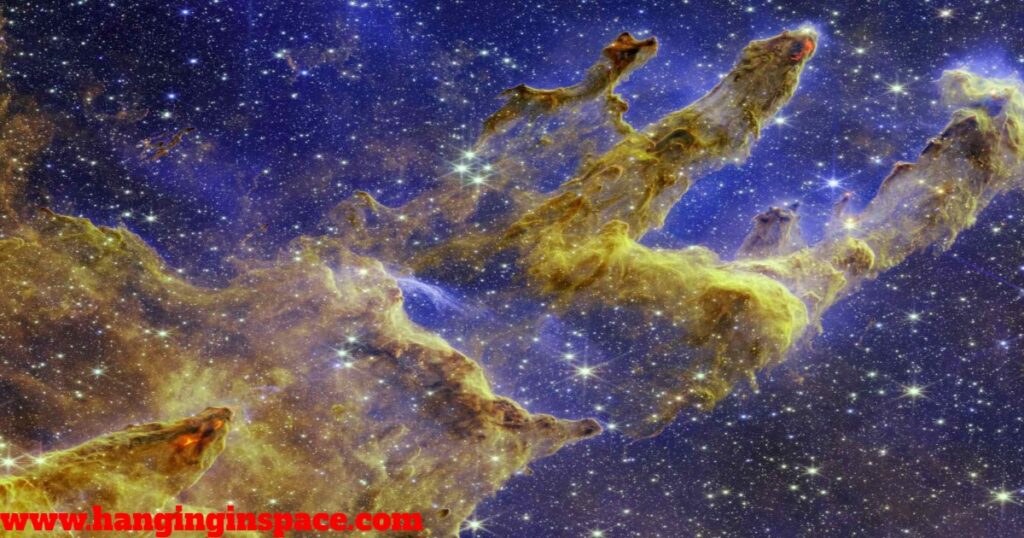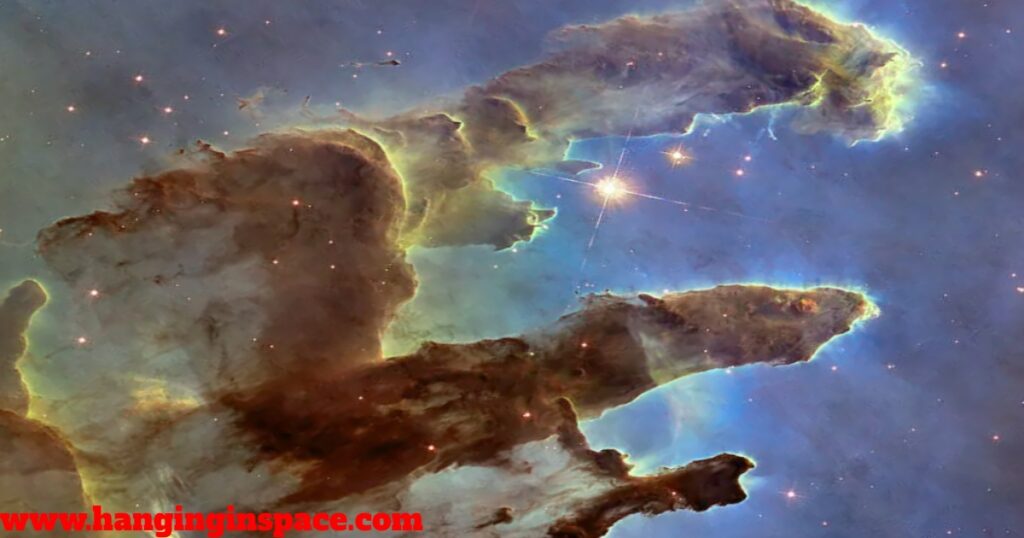The Pillars of Creation are situated in the Eagle Nebula, in the Milky Way Galaxy‘s Serpens constellation, 6,500 light years from Earth.
The pillars, which resemble arches and spires coming out of a desert, are actually constantly shifting, and they are filled with semi-transparent gas and dust. In this area, young stars are either still forming or have just begun to emerge from their dusty cocoons.

A line from Charles Spurgeon’s sermon “The Condescension of Christ” from 1857 served as the inspiration for the term Pillars of Creation.
What is the Composition of the Pillars of Creation (POC)?
The cool molecular hydrogen and dust that make up the pillars are being destroyed by photoevaporation from the ultraviolet light of hot, nearby stars. The length of the leftmost pillar is roughly four light-years.
Larger than the Solar System, the finger-like projections at the top of the clouds are visible due to the shadows cast by evaporating gaseous globules (EGGs), which protect the gas behind them from strong UV radiation. New stars are bred in eggs themselves. The EGGs eventually vanish, allowing the stars to appear.
Pillars of Creation (POC) Photograph by Hubble Space Telescope (HST):
The pillars gained notoriety following Hubble‘s initial Wide-Field Planetary Camera 2 photograph of them in 1995. The Wide Field Camera 3, a more sophisticated equipment than the original, was used to observe the features once more in late 2014.
The new camera offers a wider perspective, displaying more of the surrounding area as well as the base of the pillars, and a crisper image of the pillars because of its greater resolution.
Together with visible light, the new observations also recorded an infrared image of the pillars. The longer infrared wavelengths allow us to see more of the stars and whispy details that are generally hidden behind or inside the pillars when viewed in visible light because they can travel through the dusty environment more easily.
A jet-like structure that shoots out from one of the newborn stars inside the pillars was also observed to have changed when researchers compared Hubble’s original image of the pillars to the new one.
The jet’s length increased by 60 billion miles during the interval between observations, indicating that the material inside the jet was moving at a rate of roughly 450,000 miles per hour.

Hubble’s perspective beyond Earth’s atmosphere, its technological advancements over time, and the length of its career have all contributed to the possibility of such studies of the fine details and variations in the Eagle Nebula’s pillars, as well as of observations close and far throughout the universe.
Pillars of Creation (POC) Photograph by James Webb Space Telescope (JWST):
NASA’s James Webb Space Telescope photographed the famous Pillars of Creation in 2022. It is a lush, incredibly realistic environment. The near-infrared light picture of the Pillars of Creation by NASA‘s James Webb Space Telescope is a kaleidoscope of color.
The focal point of this Near-Infrared Camera (NIRCam) image is the newly born stars. These are the bright red orbs with eight diffraction spikes that sporadically show up. Once sufficiently massive knots form inside the pillars, they start to collapse due to gravity, warm up gradually, and eventually start to shine brightly.
There are wavy, lava-like patterns along the pillars’ edges. These are the ejections from still-forming stars. Periodically, young stars like these massive pillars of gas and dust fire forth supersonic jets that can interact with clouds of material.
Bow shocks can also occasionally emerge from this, and they can create wavy patterns similar to what a boat produces when it goes through the water. These young stars will continue to form for millions of years, their estimated age is only a few hundred thousand years.
The interstellar medium acts as a drawn curtain, obstructing Webb’s view of the vast cosmic distances beyond the pillars, despite the impression that near-infrared light has allowed Webb to “pierce through” the background.
This also explains why this image has very few distant galaxies. The deeper cosmos is hidden from our vision by this transparent veil of gas. Additionally, the combined light from the crowded “party” of stars that have broken loose from the pillars illuminates the dust.
It’s similar to staring out of a well-lit room window. The light from within bounces off the pane, hiding the outside world while spotlighting the party going on within.
Researchers will be able to update star formation models thanks to Webb’s new perspective on the Pillars of Creation. They will be able to construct a more comprehensive picture of how stars originate and explode out of these clouds over millions of years by determining far more accurate star populations in addition to the amounts of gas and dust in the area.
Conclusion:
Pillars of Creation’s beauty and significance inspire awe and deepen our understanding of the universe‘s complexities.
